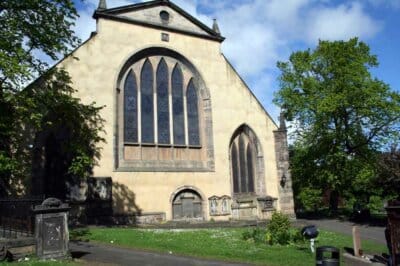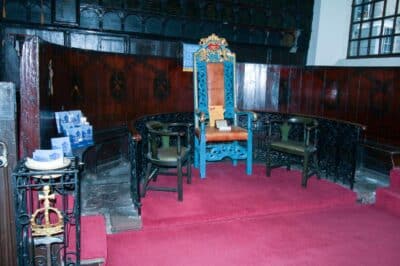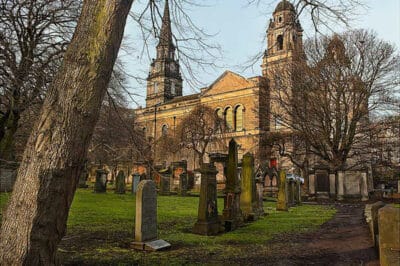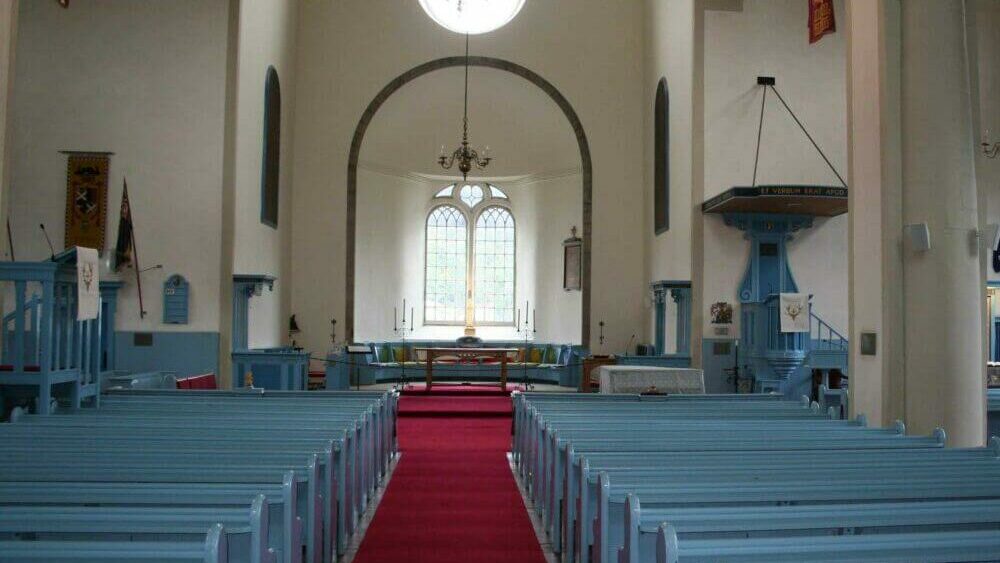
Canongate Kirk, located on Edinburgh’s Royal Mile, is a prominent and historically significant post-reformation church.
Canongate Kirk
The church was built for a congregation displaced from the Parish Church of Canongate housed in the nave of the nearby Holyrood Abbey.
It has played an important role in the religious and social life of Edinburgh for centuries.
This followed a decision by King James VII to convert the nave into a royal chapel for the Order of the Thistle.
Consequently, the king ordered that a legacy of £2,401 left in 1649 by Edinburgh merchant Thomas Moodie, described as a “pious citizen of Edinburgh,” be used to build a new church.
The ‘new’ Canongate Kirk was founded in 1688 and was completed in 1690 during the reign of William and Mary.
Above the entrance is a plaque dedicated to the ‘Mortification’ of Thomas Moodie.
Over the years, considerable upgrading and reorganisation, particularly after a fire in 1863, has changed much of the original design of architect James Smith.
The Kirk has a Dutch-style end gable with a small Doric-columned portico over the entrance.
The interior has a cruciform layout, an unusual feature for a post-Reformation, pre-Victorian Church of Scotland building.
It’s a design described by Historic Environment Scotland (HES) as “distinctively unconventional”
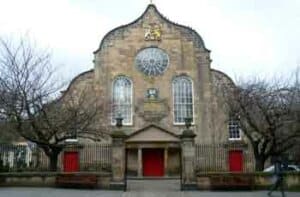
The interior colour of the Canongate Kirk is perhaps its most striking feature.
In an effort to rid the church of its dark and gloomy appearance, the pews were painted a light (baby) blue with the pulpit in a darker blue.
The walls in white are decorated with the colours from, the Royal Scots, Kings Own Scottish Borderers and others to highlight the relationship between church and military.
An early description of the interior rather unkindly described it as “lofty and bare, with no features of special interest.”
The church’s current website has a much better description. It says…
“… it is a marvellous place for sitting and meditating. Its peace, harmony and unity are promoted by its architecture…”
Canongate Kirk
The current minister (at the time of writing) the Rev Neil Gardner described Canongate Kirk, as one of the simplest buildings in Edinburgh.”
Historic Environment Scotland (Canmore) with Architecture Notes and Archaeology Notes has more information. Visit the HES website to learn more.
Canongate Kirk has a Church of Scotland congregation and is part of the parish that includes the Palace of Holyroodhouse and the nearby Scottish Parliament.
The parish also includes Edinburgh Castle, a connection said to date to the 12th century.
Consequently, you will occasionally see members of the royal family and Members of the Scottish Parliament at worship. The castle governor also has a pew in the Kirk.
Canongate Kirk: royal wedding
This wonderful building was the venue for the wedding of Princess Anne’s daughter Zara Phillips and England rugby player Mike Tindall in 2011.
It was the first royal wedding held in Scotland for almost two decades.
Canongate Kirkyard
Canongate Kirkyard, established in 1687, is part of Edinburgh World Heritage’s Graveyard Walking Trails.
This graveyard of the ‘Royal Kirk’ is the final resting place for a number of notable people including:
- Sir William Fettes, founder of Fettes College
- Adam Smith, political economist and author of The Wealth of Nations
- Dugald Stewart: philosopher, mathematician and prominent Enlightenment thinker. Nearby, on Calton Hill the prominent Dugald Stewart Monument looks over the city of Edinburgh.
- Agnes Maclehose: ‘Clarinda’ of Robert Burns’ love poems.
- David Rizzio private secretary, perhaps a lover to Mary Queen of Scots (there is no visible gravestone but tradition dictates that he is buried here).
- Dr John Walker, naturalist and University of Edinburgh Professor of Natural History.
- Robert Fergusson poet.
- Ebenezer Scroggie, an Edinburgh merchant who intriguingly may have given Charles Dickens the inspiration for his character Ebenezer Scrooge.
Robert Fergusson
At the church gate stands a statue of poet Robert Fergusson striding along the Canongate with coat-tails flapping in the wind.
Robert Fergusson (1750 – 1774) was born in Edinburgh’s Old Town and studied at the University of St Andrews.
Although Fergusson is only one among many buried in this historic graveyard he was, if you looked below the surface, a remarkable man less well-known than he deserves.
He wrote both in Scots dialect and English and his poems focused on everyday life in Edinburgh. He was an important figure in Scottish literature, whose work is sadly often overlooked today.
Edinburgh’s Cape Society
Although a member of Edinburgh’s Cape Society, described as a convivial, historical society, he suffered from severe depression and died, at the young age of 24, in the Edinburgh public asylum.
During a visit to Edinburgh in 1787, Robert Burns, a man clearly influenced by Fergusson’s work, paid for the erection of a headstone for him.
The inscription read…
“No sculptur’d marble here, nor pompus lay,
Robert Burns
No story’d urn nor animated bust;
This simple stone directs pale Scotia’s way
To pour her sorrows o’er her poet’s dust.“
With over 300 headstones, monuments and tombs, the kirkyard is a fascinating place to explore.
About the Canongate
Edinburgh’s Canongate, an ancient thoroughfare, is one of a number of streets that make up the city’s Royal Mile which runs from Edinburgh Castle to the Palace of Holyroodhouse, the official residence of the Royal family.
This famous Edinburgh street takes its name from the Augustinian canons of Holyrood Abbey, established by King David I, in 1128 and the Scots word “gait” which means way.
During the medieval period, the street was a major thoroughfare and was home to many merchants and craftsmen.
While it was outside the walls of Edinburgh’s Old Town, Canongate was a bustling and prosperous area.
However, between the 17th and 19th centuries, the street’s fortunes waxed and waned.
As Edinburgh expanded, the relative importance of it as a commercial and residential centre diminished.
By the 19th century, many of its grander homes had been subdivided into tenements, and the area faced significant social challenges.
In 1865, the Burgh of Canongate lost its independence and became part of the City of Edinburgh.
During the 20th century the Canongate faced threats of demolition and significant alteration However, preservation efforts, combined with a newfound appreciation for its historic character, led to its revitalisation.
Also on the Canongate
- A major landmark of the Canongate is the Tolbooth, which was built in 1591.
It served a variety of purposes over the years: a municipal building, a courthouse, and a jail. Today, it’s the People’s Story Museum, a venue that showcases the history of the area.
- The wonderfully peaceful Dunbar’s Close Garden lies close to the church as do the aforementioned Holyrood Abbey, Palace of Holyroodhouse and the Scottish Parliament building.
suggestions for further research & reading
- The Church of Holyroodhouse and the Parish of Canongate from the Reformation to the Revolution by J.L. Campbell (Scottish Historical Review, 1968): Examines the religious and social history of Canongate Kirk and its connection to the Palace of Holyroodhouse.
- The Royal Family and Canongate Kirk by David Brown (Proceedings of the Society of Antiquaries of Scotland, 2004): Traces the history of royal visits to Canongate Kirk and their impact on the church’s identity.
- The Fabric of a Parish Church: Building and Development at Canongate Kirk, Edinburgh, 1688-1917 by Michael Brown (Scottish Archaeological Journal, 2005): Analyzes the architectural history of Canongate Kirk and its various renovations.
- The Memorial Culture of Early Modern Edinburgh: The Case of Canongate Kirk by Rosalind Mitchison (Scottish Historical Society Magazine, 2006): Investigates the church’s funerary monuments and their significance in understanding early modern Edinburgh society.
Canongate Kirk visitor information
For information on opening hours, cost of entry and other tips to help you plan your visit, go to the official Kirk website.
